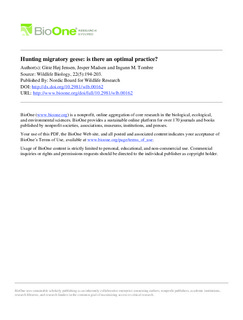| dc.description.abstract | Since the mid-20th century, many European and North American goose populations have increased dramatically in numbers, causing conflict with agricultural interests in their staging and wintering areas. In some cases, to mitigate such
impacts of rapid population increases, population control has been attempted by increasing harvest rate. In this study, we investigated how autumn-staging pink-footed geese Anser brachyrhynchus responded to hunting, with a view to determine hunting practice that would lead to an increase in the hunting bag. There was a significant increase in the distance between the hunting site and the goose flocks, on comparing goose distribution on the day before the hunt up to one day after the hunt. The effect was significant when at least 10 shots were fired per site but not when 1–10 shots were fired. The timing of shooting in relation to migratory phenology did not affect the time taken by the geese to return to the hunting site, but after a hunt in the early part of the staging season, the number of geese in the study area increased more rapidly than towards the end of the season. The maximum number of geese shot per hunting event was obtained when hunting events were separated by three days. Our results indicate that hunters can increase local harvest by temporal and spatial optimisation of practices. These results may be used as a tool in wider-scale regional and international processes to regulate
the population size of pink-footed geese by shooting, depending on the willingness of landowners, hunters and managers to coordinate hunting practices. | nb_NO |


